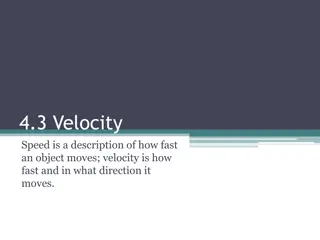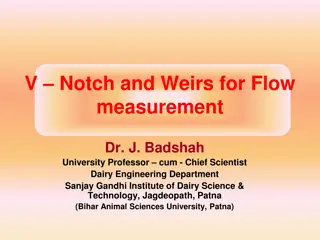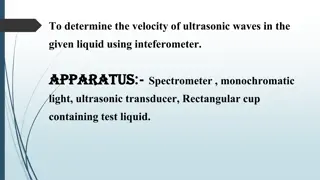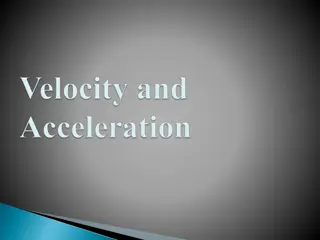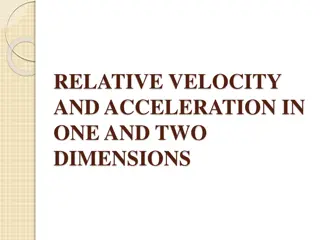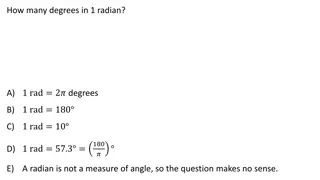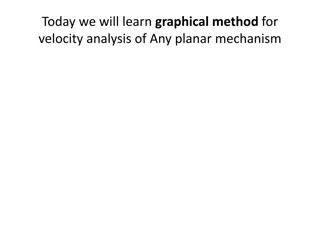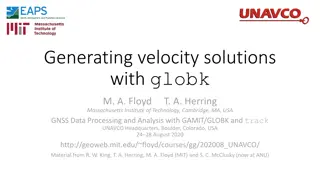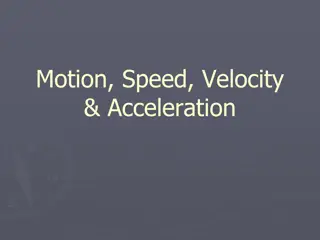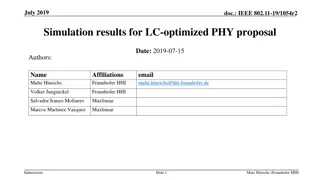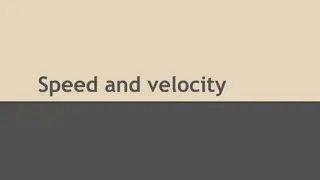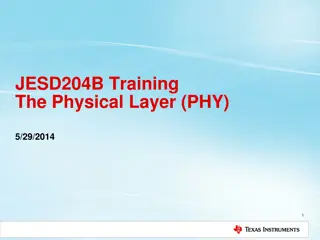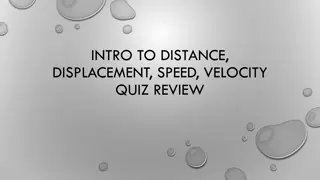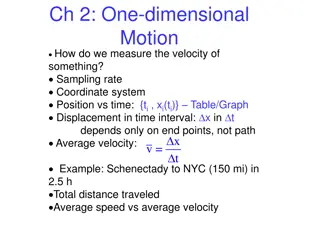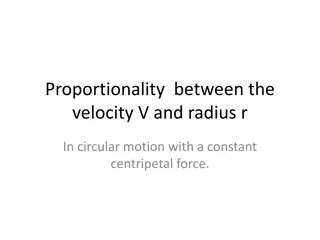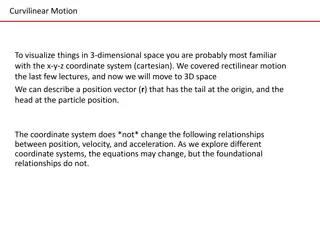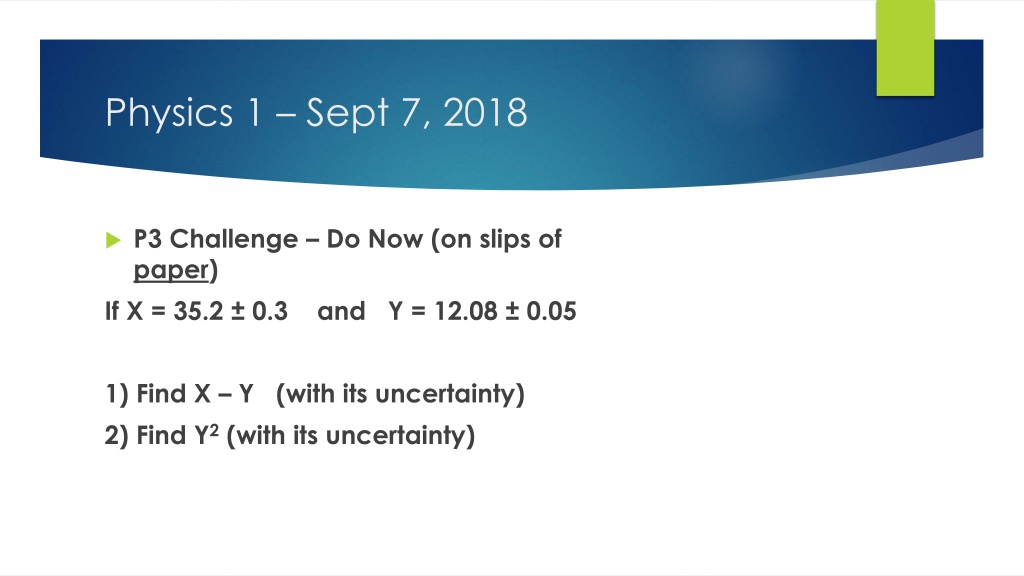
Understanding 1D Motion in Physics
Dive into the world of 1D motion in physics, exploring concepts such as position, displacement, distance, time, and average speed/velocity. Understand how to calculate uncertainties and apply equations to model motion effectively.
Download Presentation

Please find below an Image/Link to download the presentation.
The content on the website is provided AS IS for your information and personal use only. It may not be sold, licensed, or shared on other websites without obtaining consent from the author. Download presentation by click this link. If you encounter any issues during the download, it is possible that the publisher has removed the file from their server.
E N D
Presentation Transcript
Physics 1 Sept 7, 2018 P3 Challenge Do Now (on slips of paper) If X = 35.2 0.3 and Y = 12.08 0.05 1) Find X Y (with its uncertainty) 2) Find Y2(with its uncertainty)
Objectives and Agenda IB 2.1 Motion To describe and model 1D Motion with equations and graphs Agenda for IB 2.1 Motion Position, Displacement and Distance Average speed, average velocity Instantaneous velocity Acceleration X vs t graphs (time permitting) V vs t graphs (time permitting) Assignment: IB 2.1 1D Motion Practice Worksheet p 1- 2 (1 physical sheets)
Motion Strategy: start as simple as possible Point mass. At rest, relative to some frame of reference. Only defining variable: Position Restrain to move in 1 dimension: the x dimension. (or y or z) The reference position: at the origin Symbol: x0. Unit: meter, m. x0= 0 m
Position, x; Displacement, s Move to a new position, x. Displacement: s = (x x0). If s >0, positive x axis 0 If s< 0, negative x axis. The sign of s indicates the direction of the displacement. Displacement is a vector. Vectors have magnitude and direction. Vectors are modeled with an arrow. Tail at the origin, tip at the current position of the point.
Distance, d Distance: length of path traveled, d May be equal to Displacement, but may not. Displacement is a vector, distance is a scalar. Displacements may be positive or negative to indicate direction. Distances will always be positive. Distance is your odometer. Ex: An ant, starting at the origin moves 2 m in the negative direction, turns around and moves 3 m in the positive direction. A) What is the displacement of the ant? B) What distance has the ant traveled?
Time, t Convention: Clock starts when motion starts. Symbol: t Unit: seconds to= 0 sec (little o means initial ) Some later time is t Elapsed time is t = t-to Often, simply tis used for simplicity to represent the length of time from the start of the clock to the current moment.
Average Speed/Average Velocity The ratio of displacement to total time taken = Average velocity ? = ? ? The farther you can go in t time, the faster you re moving. The longer it takes you to go s displacement, the slower you re moving. The ratio of distance travelled to total time taken = Average Speed ? = ? ? Often rearranged to d = vt (Old friend, Distance = rate * time)
Instantaneous Velocity and Average Acceleration Consider an ever smaller time interval: ??? ? = ? ? When the time interval vanishes, the velocity you have is the instantaneous velocity. Your speedometer in a car measures instantaneous velocity from moment to moment. If the instantaneous velocity changes, then there has been some acceleration. Average acceleration is the ratio of the change in instantaneous velocity to the total time for the change to occur. ? = ? ?
About Acceleration Acceleration is a vector. A positive acceleration (in the + direction) is the result of An object moving in the + direction, speeding up. OR an object moving in the direction slowing down. A negative acceleration ( in the direction) is the result of An object moving in the + direction, slowing down. OR an object moving in the direction, speeding up. A larger acceleration is a large change in velocity of a given t. A larger acceleration is the same change in velocity over a shorter time.
Sample Problems A wide receiver running in the positive direction toward his own goal line at 3.5 m/s slows to 0.5 m/s still toward his own goal line in order to catch the ball 6 seconds later. What was the average acceleration for the player? A car moving at 16 m/s drives up to a yellow light and speeds to 18 m/s over 3 seconds to get through the intersection. What is the car s acceleration over this interval?
X vs t graphs We can graph position versus time to describe the motion Graph for being at rest at the origin. Graph for being at rest at some other position. Graph for moving forward, +x direction Graph for moving backward, -x direction Graph for moving at a high velocity Graph for moving at a low velocity Graph for positive acceleration, both varieties Graph for negative acceleration, both varieties
V vs t graphs We can also graph velocity versus time to describe the motion Velocity is the slope of the x vs t graph Graph for being at rest at the origin. Graph for being at rest at some other position. Graph for moving forward, +x direction Graph for moving backward, -x direction Graph for moving at a high velocity Graph for moving at a low velocity Graph for positive acceleration, both varieties Graph for negative acceleration, both varieties
Exit Slip - Assignment Exit Slip Distinguish between velocity and speed. What s Due? (Pending assignments to complete.) IB 2.1 1D Motion Practice Worksheet p 1- 2 (1 physical sheet) What s Next? (How to prepare for the next day) Study IB 2.1 (1 D) p35-37

